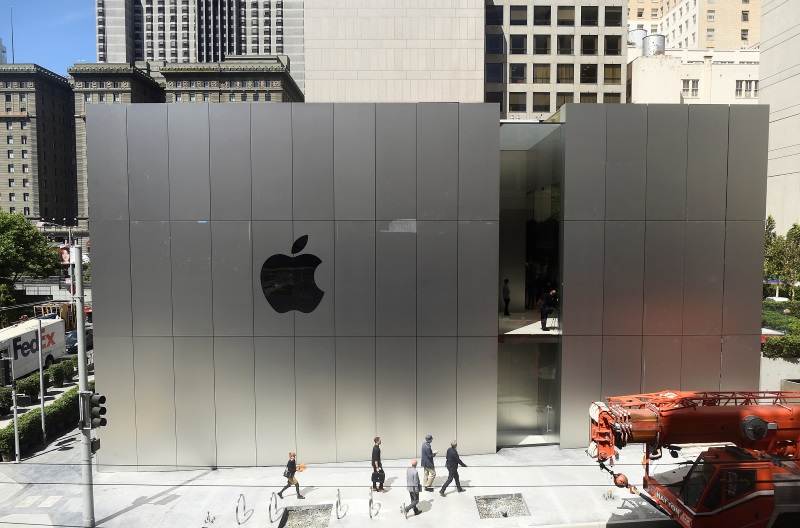- Home
- Mobiles
- Mobiles News
- Apple's Stores Getting New Look as Other Retailers Struggle
Apple's Stores Getting New Look as Other Retailers Struggle

The iPhone maker is overhauling its nearly 480 stores worldwide, starting with its new two-story location in San Francisco.
Apple provided a glimpse of its revised approach to retailing on Thursday, the 15th anniversary of the company's first stores in Virginia and California. Since then, Apple's stores have become renowned for their elegant design and employees roaming the floor offering assistance, helping make them among the most profitable in retailing.
Despite their success, the stores have been growing stale, said longtime Apple analyst Tim Bajarin of Creative Strategies.
"This is a chance to reimagine a retailing concept that Apple had already nearly perfected," Bajarin said.
Apple could use a boost. Although it remains the world's most valuable company, sales of both its iPhones and iPads have been falling as consumers increasingly hang on to the devices that they already own and hold off on upgrading. The slowdown is the main reason Apple's stock has fallen by nearly 30 percent during the past year.
The San Francisco store, scheduled to open to the public Saturday, is supposed to conjure the ambiance of a town square where people can gaze through giant windows to savor views of the city as they stroll through spacious aisles.
It also features a 42-foot-tall sliding glass door that opens up to San Francisco's busiest shopping district.
"This is a company statement, not just a retail store," Angela Ahrendts, Apple's retailing chief, said in an interview with The Associated Press.
Unless they're in San Francisco, most Apple fans won't be able to see the new look for a while. The Cupertino, California, company plans to convert about 5 to 10 percent of its existing stores to the concept annually, Ahrendts said. Some stores will probably have to be moved from their current locations in malls to accommodate all the changes.
The new layout culminates two years of research by Ahrendts, who Apple CEO Tim Cook lured away from luxury fashion brand Burberry in 2014 to restyle the stores as consumers increasingly shop online instead of brick-and-mortar merchants.
Much of that shift has been driven by the ubiquity of the iPhone and other smartphones that have made it even easier for shoppers to compare prices and buy products on the go. The upheaval is causing sales to slow or shrink at many major retailers as people spend less time at the mall.
"It is kind of our fault that retail is changing," Ahrendts said. "Therefore, we realized that we needed to do something different with our physical space."
Even Apple is being affected by the online migration, with its digital store attracting more than three times the 400 million people who visited its brick-and-mortar stores last year.
The store changes include dispersing various accessories down a row of cubicles along a wall to simulate the experience of walking from one small store to the next. Apple is calling this area "The Avenue."
Apple's heavily used "Genius Bar" for fixing problems with its devices is being renamed "Genius Grove" and being relocated into a bigger area of the store with more tables and chairs to create a more relaxing atmosphere for those who might be stressed about a malfunctioning iPhone or computer.
Apple is also setting up cubes and balls in an area called "The Forum" that can seat up to 100 people for educational sessions about photography, music and other topics covered by experts in the field. Bigger stores like the one in San Francisco will have a space called "The Boardroom" where tech startups and other small businesses can hold closed-door sessions.
The company is also earmarking outdoor space at its stores in major cities that is supposed to be like a small park that will be open to all comers around the clock.
For the latest tech news and reviews, follow Gadgets 360 on X, Facebook, WhatsApp, Threads and Google News. For the latest videos on gadgets and tech, subscribe to our YouTube channel. If you want to know everything about top influencers, follow our in-house Who'sThat360 on Instagram and YouTube.
Related Stories
- Samsung Galaxy Unpacked 2025
- ChatGPT
- Redmi Note 14 Pro+
- iPhone 16
- Apple Vision Pro
- Oneplus 12
- OnePlus Nord CE 3 Lite 5G
- iPhone 13
- Xiaomi 14 Pro
- Oppo Find N3
- Tecno Spark Go (2023)
- Realme V30
- Best Phones Under 25000
- Samsung Galaxy S24 Series
- Cryptocurrency
- iQoo 12
- Samsung Galaxy S24 Ultra
- Giottus
- Samsung Galaxy Z Flip 5
- Apple 'Scary Fast'
- Housefull 5
- GoPro Hero 12 Black Review
- Invincible Season 2
- JioGlass
- HD Ready TV
- Laptop Under 50000
- Smartwatch Under 10000
- Latest Mobile Phones
- Compare Phones
- Moto G15 Power
- Moto G15
- Realme 14x 5G
- Poco M7 Pro 5G
- Poco C75 5G
- Vivo Y300 (China)
- HMD Arc
- Lava Blaze Duo 5G
- Asus Zenbook S 14
- MacBook Pro 16-inch (M4 Max, 2024)
- Honor Pad V9
- Tecno Megapad 11
- Redmi Watch 5
- Huawei Watch Ultimate Design
- Sony 65 Inches Ultra HD (4K) LED Smart TV (KD-65X74L)
- TCL 55 Inches Ultra HD (4K) LED Smart TV (55C61B)
- Sony PlayStation 5 Pro
- Sony PlayStation 5 Slim Digital Edition
- Blue Star 1.5 Ton 3 Star Inverter Split AC (IC318DNUHC)
- Blue Star 1.5 Ton 3 Star Inverter Split AC (IA318VKU)

















